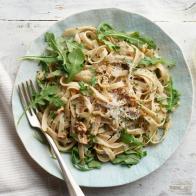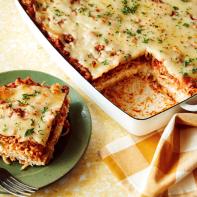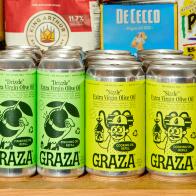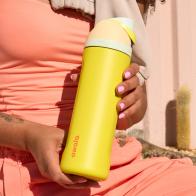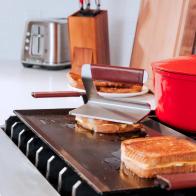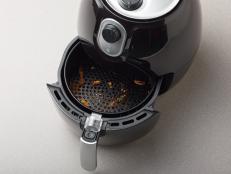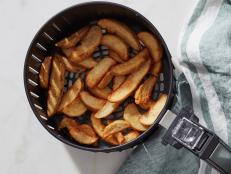What Do Clean, Disinfect, Sanitize and Sterilize Really Mean?
First things first, there's no such thing as "sterilizing" your kitchen.

demaerre/Getty Images
The terms "cleaning," "sanitizing," "disinfecting" and "sterilizing" are tossed around interchangeably, but they actually aren’t the same thing. Most surfaces in your kitchen need a good clean, and high-touch surfaces should also be disinfected or sanitized. Sterilization is pretty impossible to achieve anywhere other than a medical facility. Here's what you need to know about thoroughly cleaning your kitchen space and keep your home as spotless as possible.
What Do Clean, Disinfect, Sanitize and Sterilize Mean?
Cleaning: The act of removing visible dirt. This can be done from counter tops (like removing crumbs) or from a plate (removing the sauce that fell off your slice of pizza). It’s basically the removal of anything you can see. It can also remove some of the bacteria from the plate to the sink.
Sanitizing/Disinfecting: These terms mean the same thing. The act of sanitizing or disinfecting decreases the microorganisms on the surface to safe levels. This includes microorganisms like bacteria and viruses that you can’t see.
Sterilizing: When you sterilize, it means you get rid of 100% of the microorganisms. Sterilizing is not done in the kitchen or when handling foods. Sterilizing is done in doctors’ offices, the operating room, or in hospitals and requires special equipment.
How to Clean and Sanitize Your Kitchen
Both cleaning and sanitizing should be done in your kitchen in order to minimize the risk of foodborne illness. Cleaning should always be done before sanitizing. Here are the guidelines for each:
First, clean. Use warm soapy water to wipe countertops in your kitchen and wipe them clean with a single-use paper towel. If you want to be environmentally conscious and use a kitchen towel, make sure it has recently been washed and not used for any other task. Cleaning surfaces or dishes with warm, soapy water can remove dirt, grime, and some bacteria from a surface, but it won’t kill the bacteria (though some of the bacteria will wash down the sink or move onto your paper towel).
Your dishes, plates and cutting board can be washed in soapy water, and sanitized. If you choose to wash and sanitize your dishes in the dishwasher, make sure to pre-wash them to get off any visible dirt. Any dishes, plates, cutting board and other kitchen utensils made with dishwasher-safe non-porous materials like plastic or glass can be place in the dishwasher to be cleaned and sanitized.
Then, sanitize/disinfect. After you clean, you're ready to kill the pathogenic microorganisms (like bacteria). You can make your own sanitizer at home by mixing a solution of 1 tablespoon of liquid chlorine bleach per gallon of water. There are also commercial sanitizers or sanitizing wipes you can purchase.
To sanitize your surface, like the countertop, pour the sanitizing spray or solution on the surface and wipe it using a paper towel. The surface should be completely dry before using them again, including your sink. Commercial sanitizers should be used as per the manufacturer’s instructions listed on the label. Some commercial sanitizers require the surfaces to be rinsed after using.
The dishwasher will sanitize your dishes, but if you do not have a dishwasher you can do it by hand. You should sanitize dishes and utensils that may have come into contact with raw poultry or meat, or if someone is sick in your household. To sanitize dishes that will be washed by hand, use the homemade sanitizing solution described above. Utensils can be soaked in the sanitizing solution, while larger items like cutting boards, the sanitizing solution can be poured over it. Allow the dishes to stand a few minutes after applying the sanitizing solution, and then rinse it off with water. Finally, air-dry your dishes and utensils or dry them with a single-use paper towel or clean cloth towel used only for drying.
Other Hygeine Practices to Maintain In the Kitchen
Wash hands frequently: Use warm soapy water and lather for at least 20 seconds before rinsing the suds off with water. This should be done before and after handling or touching food.
Rinse fruits and vegetables: Use running water to rinse fruits and vegetables before using or eating. For produce with a tough exterior, like potatoes and melons, use a stiff-bristled brush to get the dirt from the cracks and crevices.
Clean the lids on canned goods: Use a wet paper towel or rinse the can under running water before opening to remove any dirt.
Sanitize your kitchen sponge: Chances are, you're not swapping out your sponge as frequently as you should be. Follow these directions to clean a lightly-used sponge.
Sanitize you phone: Your phone is harboring way more bacteria than you think. Make sure to give it a regular wipe-down with a santizing wipe before bringing it into the kitchen with you.
Toby Amidor, MS, RD, CDN, is a registered dietitian and consultant who specializes in food safety and culinary nutrition. She is the author of The Greek Yogurt Kitchen: More Than 130 Delicious, Healthy Recipes for Every Meal of the Day.
*This article was written and/or reviewed by an independent registered dietitian nutritionist.
Related Links:
